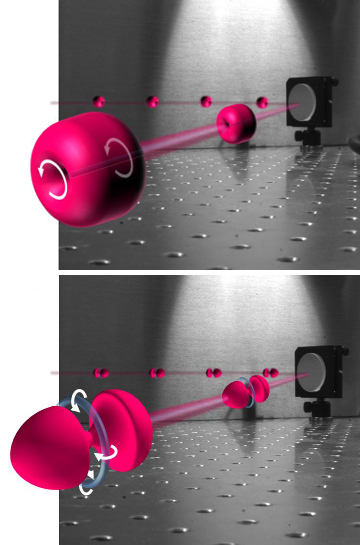
In conventional optical vortex beams (top), the phase rotates in a plane perpendicular to the propagation direction. In the newly described spatiotemporal vortex beams (bottom), the phase circulation is in the same direction as the beam’s propagation, and forms toroidal structures, resembling smoke rings, around the central self-focusing laser pulse. [Image: Howard Milchberg, University of Maryland, College Park]
For decades, scientists have studied optical vortex beams—“twisted” light in which the optical phase corkscrews around the propagation axis, with a zero-intensity singularity in the center of the beam. Scientists at the University of Maryland, College Park (UMD), USA, have now discovered another type of optical vortex: a toroidal structure that accommodates phase discontinuities in high-intensity, self-focusing laser light pulses. The resulting toroids form energy swirls in the light pulses that resemble optical “smoke rings” (Phys. Rev. X, doi: 10.1103/PhysRevX.6.031037).
According to OSA Fellow Howard Milchberg, the senior author on the study, these features—which the team has dubbed spatiotemporal optical vortices (STOVs)—have been hiding in plain sight for decades. “This is a robust, spontaneous feature that’s always there,” he said. And the team believes that this newly described structure could ultimately have applications in high-resolution microscopy, optical communications and other areas.
Self-focusing beams
In a conventional optical vortex, the light’s phase rotates in a plane perpendicular to the beam’s propagation direction, giving rise to the commonplace description of vortex beams as “twisted light.” The vortex gives the beam an orbital angular momentum that has generated considerable interest as, among other things, a potential degree-of-freedom for multiplexing, to squeeze additional bandwidth into crowded optical communications channels.
Milchberg’s team first discovered the new smoke-ring vortices in numerical experiments of self-focusing laser pulses. A self-focusing pulse occurs as a result of nonlinear light-matter interactions. When a high-power laser pulse passes through a medium such as air, it modifies the refractive index of the medium; this can, in the right circumstances, turn the medium itself into a lens that focuses the laser light still further.
In their numerical experiments, the UMD team found that as the pulse’s self-focusing increases, the core of the beam grows increasingly out of phase with the periphery, leading to an accumulating “phase shear” within the beam profile. When the core and periphery become 180 degrees out of phase, an STOV forms to accommodate the core-periphery phase discontinuity. The phase circulates not perpendicular to the propagation direction but parallel to it—like the eddies in air that form a propagating smoke ring.
“Freezing” STOVs in time
The models clearly showed that STOVs were a natural outgrowth of self-focusing beams—but could one “freeze” these ephemeral features long enough to actually get a look at one in the lab? Milchberg’s team designed a clever experiment to do just that.
The researchers sent 45-fs pulses from an 800-nm, gigawatt laser source through air to create a self-focusing beam, and placed cell of stable helium at varying distances in the propagating beam path. Helium, it turns out, is a much less efficient self-focusing medium than air; the air-helium transition had the effect of freezing the beam at a moment in time, where its characteristics could be captured in a CCD camera. By analyzing the frozen pulses at various distances to the air-helium interface, the team was able to establish that the toroidal rings predicted by the numerical experiments really did exist, and to map and establish their dynamics.
STOVs everywhere?
Although the analysis of STOVs has just begun, Milchberg and the team believe that they have the potential to cast new light on the theory and application of high-power beam propagation—now that scientists know what to look for. “Looking at a high-intensity pulse propagating through a medium and not seeing STOVs,” the paper’s lead author, grad student Nihal Jhajj, said in a press release accompanying the paper, “would be a lot like looking at a river and not seeing eddies and currents.”
In addition to creating new opportunities in basic laser research, the scientists believe that the smoke-ring vortices could also find applications in a variety of areas, much as more conventional OAM-carrying vortex beams have been used in high-resolution microscopy and in emerging communications applications. While the team’s initial work focused on the behavior of short self-focusing laser pulses in air, the researchers conclude in the paper that STOVs are likely “a fundamental and ubiquitous element of nonlinear propagation in intense pulses.”
